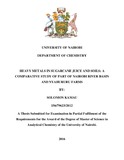| dc.description.abstract | The contamination of food is increasingly becoming a concern in developing countries due to the mounting amounts of heavy metals in urban environments. Juices are common beverages in the usual diet and contribute significantly to the nutritional intake of essential and harmful trace elements. Currently, there is inadequate information regarding the amounts of heavy metals in juice from sugarcane produced along rivers in Nairobi city. In the present study, the levels of heavy metals in sugarcane juice and soils from Nairobi and Nyahururu are determined. This study quantitatively determined the levels of heavy metals such as Fe, Cu, Zn and Mn in 32 juice samples and 16 soil samples. The analysis of the juice and soils were done using the Total Reflection X-Ray Fluorescence (TXRF) and Energy Dispersive X-Ray Fluorescence (EDXRF) techniques respectively. The general results of soil samples varied from 39958-126667, 2196-8683, 141-834 and 28.9 – 123 mg/kg for Fe, Mn, Zn and Cu respectively. The amounts of Fe, Mn, Zn and Cu in the juice varied from 4.63- 49.07, 1.82-31.38, 0.37-12.32 and 0.14-0.92 mg/l respectively. The transfer factors of the heavy metals in the sugarcane juice indicated a trend in the order: Fe < Mn < Cu < Zn. Significant differences in the trace element concentration in samples from Nairobi and Nyahururu were observed. Greater levels of Mn, Zn and Cu were observed in juice samples from Nairobi. The Zn levels in juices from Kibera and Tasia samples exceeded the Food and Agriculture Organization/World Health Organization maximum permissible limits for the metal (5mg/kg). The levels of Fe and Mn in the soils were noticeably higher than amounts observed for other heavy metals. Unlike Nairobi samples, the amounts of metals in Nyahururu samples were found to have close relationships between the various samples. It was observed that levels of Zn and Cu in Nairobi soils were higher than those from Nyahururu. The Korogosho, Dandora Mile 7, Mathare and Kibera soil samples were found to have higher concentrations of heavy metals than the rest. Some of the heavy metal levels in the soil were beyond the permitted levels for agricultural soil. Since the impact on health of human beings regarding heavy metals is usually from consumption of plants grown on contaminated soils, the data and information obtained from this study can be used to curb this problem.
Keywords: accumulation, heavy metals, Saccharum officinarum and transfer factors | en_US |



